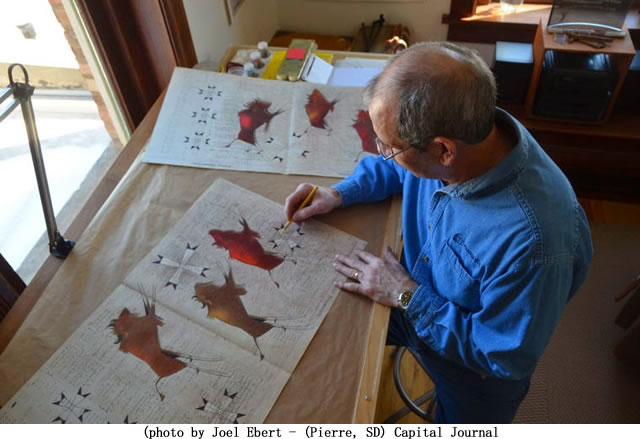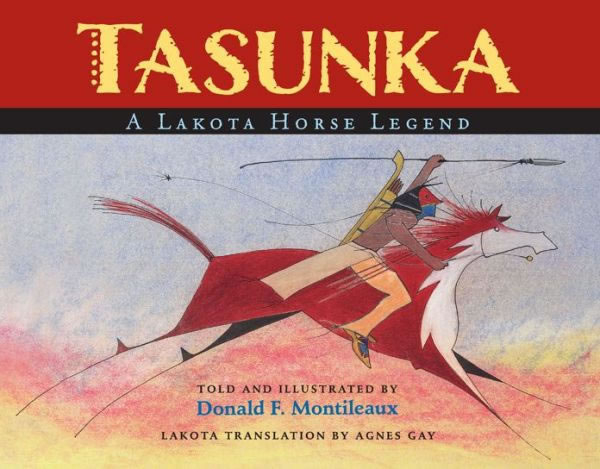 |
Canku Ota
|
 |
|
(Many Paths)
|
||
|
An Online Newsletter
Celebrating Native America
|
||
|
September 2014 - Volume
12 Number 9
|
||
|
|
||
|
Renowned SD Ledger
Artist Authors Children's Book
|
||
|
by Joel Ebert - (Pierre
SD) Capital Journal
|
||
|
PIERRE, S.D. – Donald Montileaux grew up listening to his father tell Lakota stories. They were stories passed down from father to son for generations. Now that rich history of Native American storytelling is taking on a new form. Montileaux is one of many South Dakota artists who create visual depictions of Native American legends and scenes using old accounting ledgers. The Native art form originated in about 1870, when buffalo hide became scarce, Montileaux said, and was popular until about 1940. Native Americans would barter for ledger books with local accountants so they could illustrate their stories, which until then were only shared orally. Using his talent for creating unique-looking horses through ledger art, Montileaux authored "Tasunka: A Lakota Horse Legend." Already an award-winning artist for his ledger work, Montileaux's latest project is a new outlet. Named after the first Lakota horse, the nearly 50-page book tells the story of the Lakota people's horse and the journey they make when the horse is taken away by the Great Spirit. "Tasunka" is a learning book, Montileaux said, and children are the target audience. "The book is an educational tool for teachers to use for children," he said. "Through this book, hopefully we can knock down some prejudices."
A member of the Oglala Lakota tribe, Montileaux created the book after being inspired by a recent telling of the tale. Although Montileaux had heard the story of Tasunka many times throughout his life, it wasn't until he heard Alex White Plume recall the tale during a trip to the Badlands in 2005 that he decided to put the legend on paper. Montileaux started working on the book three years ago and it was recently released by the South Dakota State Historical Society Press. Using his lavish drawings, Montileaux put on paper a story that has been kept alive through oral storytelling, perhaps for centuries. Montileaux said it was important to retell the tradition accurately. "In our culture, storytellers have to have someone to verify the story," he said. That verification came through a long process, during which Montileaux worked closely with White Plume and Agnes Gay, who translated the story into Lakota. He also worked with a local photographer who sent his hand-drawn images to a designer in California. While putting the book together, Montileaux used his granddaughters as a sounding board. "I wanted to keep it a simple style," he said. "But I realized color was essential." Montileaux used pastels to create vibrant blue, green and red backdrops. He worked to give the scenes depicted on each page of "Tasunka" a quality that allows the images to almost leap off the page. Montileaux labored for years to perfect the horse images found in "Tasunka." His latest horses, which he calls very simplistic, have no hooves. The hoofless horses create a sort of flying effect, Montileaux says. "Tasunka" also features unusually colorful animals such as a bright blue horse. The idea for that, Montileaux said, comes from a legend of the famous Lakota Chief Sitting Bull, who would only ride blue roan horses. When the finished book finally arrived at his studio in downtown Rapid City, Montileaux felt at ease. "It's like birthing a kid," he said. Though the three-year project was different than any of Montileaux's previous work, he said he plans to create more books based on Lakota legends using the network of storytellers, translators and designers he gathered for "Tasunka." He'll also rely on the same panel of tough critics. "I will continue to use my grandchildren as a sounding board," he said.
|
|
|
||
|
|
||
| Canku Ota is a free Newsletter celebrating Native America, its traditions and accomplishments . We do not provide subscriber or visitor names to anyone. Some articles presented in Canku Ota may contain copyright material. We have received appropriate permissions for republishing any articles. Material appearing here is distributed without profit or monetary gain to those who have expressed an interest. This is in accordance with Title 17 U.S.C. Section 107. | ||
|
Canku Ota is a copyright ©
2000 - 2013 of Vicki Williams Barry and Paul Barry.
|
||
 |
 |
|
|
The "Canku
Ota - A Newsletter Celebrating Native America" web site and
its design is the
|
||
|
Copyright ©
1999 - 2013 of Paul C. Barry.
|
||
|
All Rights Reserved.
|
||

